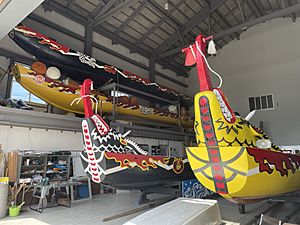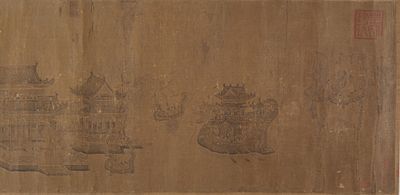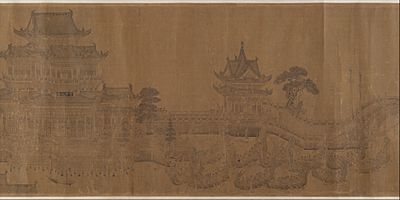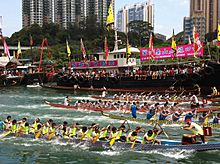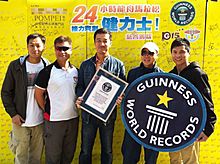Dragon boat facts for kids

|
|
| Highest governing body | International Dragon Boat Federation |
|---|---|
| First developed | Ancient China |
| Characteristics | |
| Contact | No |
| Team members | 22 (regulation) |
| Type | Watercraft paddle sport |
| Equipment | Dragon boat, paddles, drum |
| Presence | |
| Country or region | Worldwide |
| Olympic | No |
| World Games | 2005 (invitational), 2009 (invitational) |
| Dragon boat | |||||||||||||||||
|---|---|---|---|---|---|---|---|---|---|---|---|---|---|---|---|---|---|
| Traditional Chinese | 龍舟 | ||||||||||||||||
| Simplified Chinese | 龙舟 | ||||||||||||||||
|
|||||||||||||||||
| Alternative Chinese name | |||||||||||||||||
| Traditional Chinese | 龍船 | ||||||||||||||||
| Simplified Chinese | 龙船 | ||||||||||||||||
|
|||||||||||||||||
A dragon boat is a special boat powered by people using paddles. It first came from the Pearl River Delta area in southern China. These boats were traditionally made from teak wood. Dragon boats are part of a family of long, paddled boats found across Asia, Africa, the Pacific islands, and Puerto Rico.
The sport of dragon boat racing has a long history. It started over 2000 years ago in southern China as an old folk ritual. It even has connections to the very first Olympia games in ancient Greece. Both dragon boat racing and the ancient Olympics included religious ceremonies, community parties, and competitions.
Dragon boat racing has been a Chinese tradition for over 2000 years. It became a modern international sport in Hong Kong in 1976. Today's boats are often made from strong, light materials like carbon fiber and fiberglass. For races, dragon boats usually have fancy Chinese dragon heads and tails. During practice, these decorations are often removed. A standard racing boat has 18-20 paddlers, plus a steersperson and a drummer. Smaller boats have 8-10 paddlers.
In December 2007, the Chinese government made the Dragon Boat Festival a national holiday. This shows how important the tradition is.
Contents
What is a Dragon Boat Made Of?
The materials used to build a dragon boat are very important. They affect how well the boat performs and how long it lasts. The boat's frame needs to be strong and durable. The main body, called the hull, should be light and waterproof. This helps the boat glide smoothly through the water.
The Ancient Story of Dragon Boats
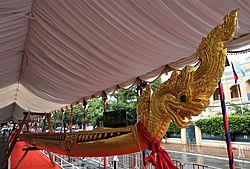
Dragon boat racing has a rich history filled with old ceremonies and traditions. The competitive sport we see today is just one small part of this culture. Experts believe dragon boat racing started in southern China over 2500 years ago. This was around the same time the ancient games began in Olympia.
Since then, dragon boat racing has been a continuous tradition. It is part of yearly water rituals and festivals. People used it to honor the Chinese dragon water deity. This celebration was very important for ancient Chinese farmers. It marked the summer rice planting season. Dragon boat racing was common in areas where rice was grown in south-central China.
Of the twelve animals in the traditional Chinese zodiac, only the Dragon is a mythical creature. All the other animals are real. In Chinese tradition, dragons were believed to rule all water: rivers, lakes, seas, and even rain clouds. There are different types of dragons, like earth dragons and sky dragons. Unlike dragons in European mythology, which are often seen as evil, Asian dragons are usually good and kind. People honored them, rather than trying to defeat them.

Traditional dragon boat races in China happen on the 5th day of the 5th Chinese lunar month. This usually falls in late May or June. This time of year is close to the summer solstice, around June 21st. The Chinese call their festival "Duan Wu" or "Duen Ng." The sun and the dragon are seen as male and powerful. They are thought to be strongest during this time of year. This is why people celebrate with dragon boat races. It is also when rice seedlings are moved to the fields for growing. "Duan Wu" means the sun is at its highest point in the sky, like at 'high noon'. It refers to the longest day of the year in the northern hemisphere.
Honoring the dragon deity was meant to prevent bad luck and encourage rainfall. Rain is vital for healthy crops and a good harvest. Celestial dragons were believed to control rain, winds, and clouds. The Emperor was sometimes called "The Dragon" or "Son of Heaven." Chinese people sometimes call themselves "dragons" because it means strength and energy. If there wasn't enough rain, it could lead to drought and hunger. So, honoring dragons in China was linked to yearly rituals for life-giving water and plenty of rice.
Another special ritual is called Awakening of the Dragon. A Taoist priest would paint dots on the eyes of the carved dragon head on the boat. This symbolizes the dragon waking up and getting its energy back. In modern festivals, a person might be invited to paint the dragon's eyes with red paint.
In the 19th century, Europeans saw these racing rituals and called them a "dragon boat festival." This name became popular in the West. Dragon boat racing is celebrated in many parts of east Asia where many ethnic Chinese people live. These places include Singapore, Malaysia, and the Riau Islands. The Ryukyu Islands have also adopted this tradition. The races are often called the "double fifth" because they happen on the fifth day of the fifth lunar month. This date changes each year on the Gregorian calendar.

The Khmer Empire used dragon boats in their naval battles long ago. Today, Cambodia honors this history with dragon boat races at the Bon Om Touk water festival. Laos, which has historical ties to the Khmer Empire, also has a similar dragon boat festival called Boun Suang Huea on the Mekong River. The world's longest dragon boat, the Kambojika Putta Khemara Tarei, is located in Cambodia.
Who is in a Dragon Boat Crew?
A standard dragon boat team usually has 22 members. There are 20 paddlers who sit in pairs, facing the front of the boat. One drummer sits at the front, facing the paddlers. One steerer stands at the back of the boat. Dragon boats can be different lengths, so the crew size changes. Small boats might have only 10 paddlers. Traditional boats can have over 50 paddlers, plus drummers and a steerer.
The Drummer
The drummer's beats are like the "heartbeat" of the dragon boat. The drummer guides the paddlers during a race. They use the rhythm of the drum to show how fast and in sync everyone should paddle. This helps the team speed up, slow down, or keep a steady pace. The drummer can also use hand signals and shouts to encourage the crew. In official races, the drummer must actually hit the drum. If they don't, the team might get a penalty. During practice, an experienced team might not need the drum if they can paddle well together.
A good drummer should match their drumming to the strokes of the first two paddlers. This helps everyone stay together.
The Paddlers
Paddlers sit in pairs, facing forward in the boat. They use a special type of paddle. Unlike rowing, the paddle is not attached to the boat. Paddlers face the direction the boat is moving, like in a canoe. Rowers, however, face the opposite direction.
The International Dragon Boat Organization has a standard paddle design. It has a specific blade shape and size. This design comes from paddles used by people in the Pearl River delta area of China.
The first pair of paddlers are called "pacers" or "strokes." They set the speed for the team. It's very important that all paddlers stay in sync with each other. The steerer guides the boat's direction during a race. But for docking or other moves, the drummer or steerer might tell individual paddlers to paddle.
There are three main types of strokes paddlers use: a normal forward stroke, a backstroke, and a draw stroke.
The Steerer
The person standing at the back of the boat controls its direction. This person is called the steerer, steersperson, or sweep.
The steerer uses a long oar, usually about 9 feet long, called a steering oar. This oar fits into a special holder called an oar lock. The oar lock keeps the oar in place but lets it pivot. It sits on a steering arm that sticks out from the back-left of the boat.
The steerer uses the oar to guide the boat. They put the oar blade in the water and either push the handle away or pull it towards them. This turns the boat right or left.
A steerer can also "crank" the steering oar to adjust the boat's position. When they crank, the back of the boat moves left or right, spinning the boat. This is useful for turning the boat around during practice or lining it up straight for a race.
Steerers also use calls to direct the paddlers. They might call "paddles up" to get ready to paddle. Then, "take it away!" to start paddling. Other calls include "hold the boat" for paddlers to brake with their paddles. Or "let it ride" for them to lift their paddles out of the water. The steerer also makes calls during the race to help the team improve their speed and finish time.
Dragon Boat Racing Events
Modern dragon boat racing is managed by the International Dragon Boat Federation (IDBF). This is the main organization for the sport worldwide. The IDBF is part of the Global Association of International Sports Federations. The International Canoe Federation (ICF) also has a dragon boat program. Both competitive and festival races are very popular. Many paddlers train all year, using paddling machines or pools, as well as practicing on the water.
A festival race is usually a short sprint, often 500 meters long. Other common distances in international competitions are 200, 1000, and 2000 meters. A 2000-meter race is usually done on a 500-meter course. Teams complete two loops, starting and finishing at the same end. This means they make three 180-degree turns. Local festivals might use other distances, like 100 or 250 meters, depending on the size of the water.
|
See also
- Nouka Baich


